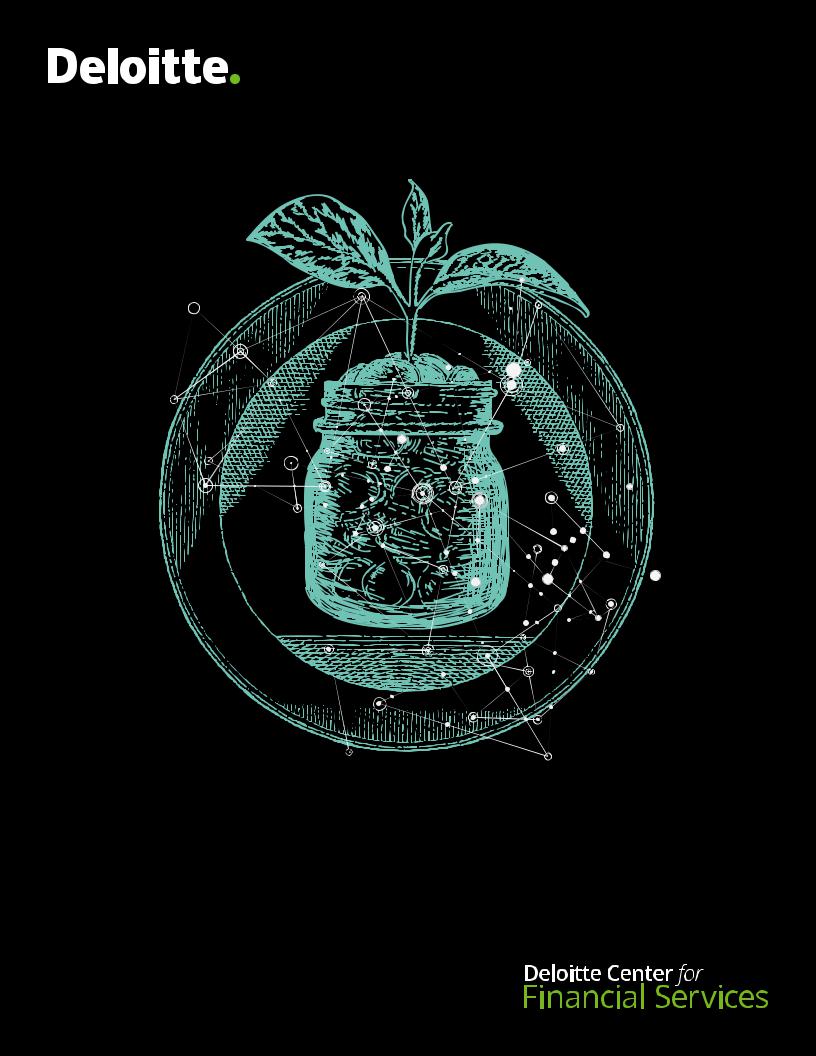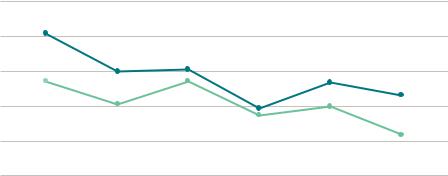
металлы экономика
.pdf
vk.com/id446425943
2019 Investment Management Outlook
A mix of opportunity and challenge

vk.com/id446425943
2019 Investment Management Outlook: A mix of opportunity and challenge
2

vk.com/id446425943
Brochure / report title goes here | Section title goes here
Table of contents
2019: Another year of challenges with new opportunities for success |
1 |
Picking the right growth options |
3 |
Creating operational efficiencies |
8 |
Delivering the next level of customer experience |
13 |
2019: Execution drives success |
15 |
02

vk.com/id446425943
2019 Investment Management Outlook: A mix of opportunity and challenge
2019: Another year of challenges with new opportunities for success
Investment management is in a period of rapid change, driven by shifting investor preferences, margin compression, regulatory developments, and advancing technologies. While the nine-year bull run has diminished the intensity of these industry challenges, experience tells us that markets work in cycles. Successful investment managers (which
we define as managers of mutual funds, hedge funds, and private equity firms) in 2019 will likely be the ones that can continue to manage these challenges with plans designed to withstand changing market conditions.
Priorities for long-only managers are more acute than those for alternative managers
Passive funds continue to garner assets. In the first half of 2018, 16 of the top 20 funds by net flows were passive mutual funds and exchange-traded funds (ETFs) garnering $143 billion.1 The advent of zero-cost ETFs may accelerate this growth even further. According to State Street Global Advisors’ estimates and Investment Company Institute’s data, global ETF assets could touch the $25 trillion mark by the end of 2025, up from $4.8 trillion in 2018.2,3
At the same time, making the case for alpha for many active managers remains a challenge. A study has shown that 86.7 percent of US active funds have underperformed their benchmark, on a net-of-fees basis, over the 10-year period ending in 2017.4 European funds have similar results:
85.4 percent of actively managed European equity funds underperformed their benchmark over the same period.5
In the private equity (PE) world, consistent strong performance rewarded accredited and institutional investors, which led to large capital inflows and record dry powder (undeployed capital) (figure 1). As of March 2018, global PE dry powder stood at $1 trillion, ready to be
invested in new portfolio companies with growth potential.6
Figure 1. PE funds exhibit strong performance globally
Horizon internal rate of return
25%
20.5%
20%
15.0% 15.2%
15% |
13.4% |
11.4%
10% |
13.6% |
13.7% |
9.8% |
|
10.2% |
|
|
|
|
|
|
9.1% |
9.9% |
|
|
|
|
|
|
5% |
|
|
|
|
5.4%
0%
1-year |
3-year |
5-year |
10-year |
15-year |
18-year |
||
|
|
Private equity funds―global |
|
|
S&P 500 |
|
|
|
|
|
|
|
|||
Data as of 12/31/2017
Source: Global PE & VC Fund Performance Report, PitchBook.
1
vk.com/id446425943
Customer preferences are diverging
Expectations are diverging between investor segments.
Most Millennials and Gen Z (born from 1995 to 2010) have made a quantum change in their investment practices from those of their parents. These cohorts will eventually hold a significant share of global investable assets as
the multitrillion-dollar intergenerational wealth transfer progresses in the United States and Europe.7 They tend to prefer engaging with online and mobile channels, a low minimum initial investment amount, and 24/7 access to investment advice on smart devices. Meanwhile, more experienced segments (Gen X and Baby Boomers) are often expecting elegant interactions through their mobile and online investment accounts and professional advice on demand. On the other side of the spectrum, most institutional investors are demanding better portfolio transparency, tailored investment solutions, and
global products.
Regulatory fragmentation continues
Securities regulations across the United States, Europe, and
Asia are changing according to diverse priorities. Navigating multiple regulatory regimes could be challenging for many global investment management firms. In addition, the onset of new rulings globally will likely complicate regulatory compliance management in 2019. Building regulatory-ready organizations to manage change as though it is ever-present may improve efficiency as firms manage regulatory and compliance risk.8
2019 Investment Management Outlook: A mix of opportunity and challenge
Tech-savvy firms are putting pressure on traditional firms
Many investment management firms are planning for potential disruption caused by new technology-based entrants. These disruptors could shake up online fund distribution, digital advice, or micro-investing with their expertise in digital experience delivery or large customer bases. These potential new entrants are likely to provide low-cost services, coupled with digital-age capabilities, aiming to build relationships with Millennial and Gen Z cohorts before they are targeted by incumbent firms.
Given this complex and challenging industry environment, investment management business leaders should consider three core questions:
1.How can we grow our business?
2.What are the possibilities to run our operations more efficiently?
3.How can we deliver the next level of customer experience?
The answers to these questions are typically particular to each organization and tend to evolve over time. Investment management firms that address them with bold, strategic investments and effective execution are more likely to achieve success.
Regulatory change is driving many firms to commit resources to evaluate and change their operating models to meet their plans for growth and efficiency.
―Patrick Henry, Vice Chairman, US Investment Management leader, Deloitte & Touche LLP
2

vk.com/id446425943
2019 Investment Management Outlook: A mix of opportunity and challenge
Picking the right growth options
While many investors have been enriched with the continuation of the longest bull market since World War II, some investment managers are taking a more cautious stance.9 As valuations rise, so does the likelihood of market volatility or perhaps even a correction. Adding to the investment manager’s angst, fee pressure and margin
compression have persisted for many investment managers throughout this bull market. In such an environment, one of the biggest challenges for investment managers is to obtain profitable growth.
Figure 2. Growth matrix for investment managers
Investment managers are pursuing a variety of organic and inorganic strategies to achieve their overall objectives
market |
Market development |
Diversification |
|||
New |
|||||
• |
Local partners and |
• |
M&As |
||
|
|||||
|
|
long-term view for China |
• |
Minority acquisitions |
|
|
|
and APAC market |
|
|
|
|
• |
Acquisitions |
|
|
|
market |
Market expansion |
Product development |
|||
Current |
|||||
• |
Alternative data |
• |
Artificial intelligence |
||
• |
Shelf-space rationalization |
• |
Innovative pricing models |
||
|
|
for distributors |
• |
Environmental, social, |
|
|
|
|
|
and governance (ESG) |
|
|
|
|
|
products |
|
|
|
Existing products |
|
New products |
|
Some larger investment managers have used their scale to expand profit margins, while offering products at lower
costs.10 A study covering more than 95 investment managers with a combined $35 trillion in assets under management
(AUM) found that the leading investment managers increased median operating margins to 35 percent over the 2014–2017 period, outperforming their peers by 4 percentage points.11 Some of these firms have done so by investing in new technology, which can in turn improve investment analytics performance and efficiency, while freeing resources for more profitable activities. Success has been concentrated to these leaders, thereby building a trusted brand among investors. These firms have leveraged this trust to command a 19 percent fee premium relative
to competitors.12 Many small and midsized investment managers, lacking scale, are battling to maintain profitability. For these firms, making the right investment choices for market and product development (figure 2) is imperative for sustained growth.
Source: Deloitte Center for Financial Services analysis.
3

vk.com/id446425943
2019 Investment Management Outlook: A mix of opportunity and challenge
Diversification: Acquisitions and minority stakes lead the way
Many investment managers are hunting for strategic acquisitions. These acquisitions can add new markets, product offerings, and investment capabilities. The net result is that valuations for deals offering such capability enhancement are increasing.13 In fact, 2018 has seen more $1 billion plus deals than any of the previous five years.14 Diversification strategies (i.e., adding new products in new markets) are often realized through acquisitions. Indeed, the fast-growing ETF segment has seen a wave of acquisitions in the last few years. In September 2017, Invesco announced the acquisition of Guggenheim Investments’ ETF business for $1.2 billion.15 The acquisition may help Invesco on two fronts—complementing the existing self-indexing capability and expanding global ETF market share.16
Many investment managers are also seeking minority stakes to enter new markets. A leading US investment manager’s recent investment in micro-investing app Acorns helps them understand how to engage younger (i.e., Generation Z) investors in a mobile-first world.17 The deal may also help the incumbent firm diversify its distribution capability into apps and chatbots.18
Market development: Partnerships and long-term view for crossing the Great Wall of China
Most global investment managers have locked their gazes on China, India, and Asia Pacific for further growth. The
Chinese market attracts particular interest, considering the recent relaxation of ownership requirements for foreign firms.19 A strong shift in investment preference is also underway as the savings culture transitions to personal investing, with millions of Chinese citizens focusing on retirement.20 These factors are expected to drive China
to become the second-largest investment management market globally, powered by double-digit growth in net-new flows.21 In fact, retail and high-net-worth investors in China are expected to represent more than $17 trillion in AUM by 2030.22 The conversation has moved from “Should we enter these markets?” to “How can we build a successful investment management business here?” Many firms
have already established their foothold in China via local partnerships and are building their presence for the long term. Regulatory modifications like the Asia Region Funds Passport, pioneered by Australia, Japan, New Zealand,
South Korea, and Thailand, could foster cross-border fund distribution in the Asia Pacific region.23 However, investment managers should expect a long road ahead because of
the cultural diversity, regional complexities, and regulatory challenges present in this market.
Chinese expansion
UBS Asset Management has built its presence in China through joint ventures and partnerships with local firms. In 2005, a joint venture with State Development & Investment Corporation (SDIC) enabled UBS Asset Management to offer onshore mutual funds in China, while a wholly-owned enterprise for alternative investments was set up in 2011.24 The growth potential of the Chinese market was highlighted when assets managed by UBS SDIC Fund Management Co. touched
$30 billion in 2018, from $250 million in 2006.25 As part of the company’s long-term plans to offer China exposure for onshore and offshore investors, UBS Asset Management launched an onshore equity fund in November 2017. It was followed by two bond funds in May and September 2018. These three funds were launched via the private fund management wholly foreign-owned enterprise in Shanghai.26, 27
4

vk.com/id446425943
2019 Investment Management Outlook: A mix of opportunity and challenge
Market expansion: Alternative data sets and shelfspace rationalization to the fore
Differentiation via alpha generation is an optimal way to gain assets. Investment managers continue to explore new alternative data sets to drive organic growth through differentiated alpha generation. Already adopted by some hedge funds and other alternative investment managers, long-only funds are now exploring the integration of alternative data in their investment processes.28 A leading
US-based investment manager recently launched a series of active funds that utilize an assortment of alternative data sets in the pursuit for alpha.29 Investment insights are not the only application of alternative data that investment managers are focusing on. Goldman Sachs has built a team to identify internal data that could be of potential use to clients in investment and risk management.30
As organic growth slows, protecting shelf space and
AUM will likely come to the fore in 2019 as a key tactic for remaining competitive. Rising cost pressures and investor preference for low-cost funds have led many distributors to cull funds from their platforms (figure 3). This shelf-space rationalization trend was accelerated by the US Department of Laborʼs fiduciary rule. Even after the rule was overturned, the trend persists among distributors. For many incumbent firms, retaining shelf space may be most important for success. The surest route for active managers to retain shelf space is by consistently delivering alpha.
Figure 3. Five of the eight leading mutual fund distributors have rationalized shelf space by dropping more than 4,900 funds from their platforms over the last two years
These five distributors cut the number of funds offered by an average of 28%.
2016 |
2018 |
Source: CitywireUSA, Deloitte Center for Financial Services analysis.
5
vk.com/id446425943
Product development: Reimagining investing using artificial intelligence, ESG, and innovative pricing models
Artificial intelligence (AI) has graduated from a buzzword to an enabler that offers differentiated capabilities across the investment value chain. Deloitteʼs 2018 Investment Management Outlook covered the role of AI algorithms in understanding market patterns and making investment decisions.31 The technology has now reportedly found promising applications in enhancing wealth advisory services, offering customized portfolios, and digitizing customer service.32 Morgan Stanley is combining machine learning (ML) algorithms with predictive analytics to help its 16,000 financial advisers generate more insights and provide customized advice for clients.33 The ML algorithms are designed to browse through research reports, diverse data sets, and news articles to not only generate unique insights for future investments, but also better understand the potential impact of events on clients’ portfolios.34
Launched in early 2018, a leading investment manager’s suite of ETFs uses natural language processing (NLP) to scan regulatory filings of companies to create a proprietary index.35 The firm has replaced the index provider with AI capability contributing to the investment manager’s ability to offer the funds at lower cost than traditional index ETFs.
Acquisitions and partnerships can provide a more immediate solution for firms that wish to incorporate AI or related capabilities in new products. Some investment managers are acquiring robo-advisers to offer custom portfolio solutions for independent advisers as well as traditional wirehouse representatives.36 Imagine receiving
investment advice directly from the chief investment officer of a major bank. AI is enabling one large European bank
to provide this service today.37 This widening application of AI across the investment value chain increases the possibilities of a shift in the business model, especially across customer touchpoints.
2019 Investment Management Outlook: A mix of opportunity and challenge
Aside from expanding capabilities across the value chain, investment managers have worked to keep their product offerings from becoming stale. For example, the availability of products with an investment mandate that complies with ESG issues is seeing a strong uptick. Greater social awareness from Millennials, pension funds’ long-term horizon, and favorable regulatory changes are driving the increased interest toward ESG investing.38,39 Investment managers are preparing for this rising demand with 90 percent of US managers planning to integrate ESG in their product development plans.40 While ESG products have the strongest foothold in Europe, increased client interest has led to Asian managers also handing out ESG mandates.41
A new pricing model for passive funds has emerged: free. The announcement of a no-fee fund was a seismic shift for the industry.42 With other investment managers also
following suit with the launch of zero-commission platforms, firms’ revenue-generation focus now moves toward securities lending, order-flow payments, and shareholderservicing fees.43 Larger investment managers will likely also use these zero-fee products to sell other offerings and keep investors within the fund family. Active funds are also seeing resurgence of a pricing model. A “fulcrum model” links fees to fund performance and charges a base fee if the fund does not outperform its benchmark. If the fund achieves alpha, an additional performance fee is charged. Such variable fee structures may create a win-win situation, delivering better net returns to investors and incentivizing fund managers on performance. Allianz Global Investors has been one of the early adopters of a performance-based fee model in the United Kingdom. Investors are charged a base fee of 20 bps and an outperformance fee of 20 percent on the performance over the benchmark.44
6

vk.com/id446425943
2019 Investment Management Outlook: A mix of opportunity and challenge
Predictions for 2019
••Crossing the Great Wall. The traditional global operating model for investment managers may not lead to success in China and other Asia Pacific markets. The firm that succeeds in these markets will boast an operating model focused on distribution agility, local partnerships, and product transparency.
••Fulcrum fees for new active funds. A couple of investment managers have adopted the “fulcrum fee” model, in which the investment manager is rewarded for generating alpha. This trend could accelerate with more than 10 firms adopting this pricing approach in the next 12–18 months.
The bottom line on growth:
Key actions the investment management C-suite should consider
Investment managers can consider the following steps to drive growth:
•• Invest in data storage and analytics. Adopting alternative data sets and AI have proved to be a differentiating factor for alpha generation. Firms should invest in greater processing power and data storage to stay competitive.
•• Be aggressive when acquiring new capabilities.As the gold rush for M&A and minority stakes is expected to continue over the next 12–18 months, investment managers would be better served by pursuing deals, even pricey at some levels, that would add capabilities aligned with their strategic objectives.
7
